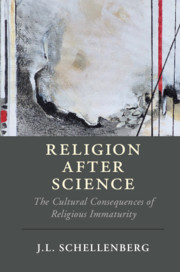Book contents
- Religion After Science
- Cambridge Studies in Religion, Philosophy, and Society
- Religion After Science
- Copyright page
- Dedication
- Contents
- Acknowledgments
- Prologue: The 10,000-Year Test
- 1 Development and the Divine
- 2 The End Is Not Near
- 3 Big Ambitions
- 4 A Poor Record
- 5 Verdict: Immature, Not Doomed
- 6 A New Path for Science and Religion
- 7 The New Agnosticism
- 8 Naturalism Tamed
- 9 Agnostic Religion?
- 10 The New Humanism
- Epilogue: The Religion Project
- Notes
- Index
2 - The End Is Not Near
Published online by Cambridge University Press: 09 August 2019
- Religion After Science
- Cambridge Studies in Religion, Philosophy, and Society
- Religion After Science
- Copyright page
- Dedication
- Contents
- Acknowledgments
- Prologue: The 10,000-Year Test
- 1 Development and the Divine
- 2 The End Is Not Near
- 3 Big Ambitions
- 4 A Poor Record
- 5 Verdict: Immature, Not Doomed
- 6 A New Path for Science and Religion
- 7 The New Agnosticism
- 8 Naturalism Tamed
- 9 Agnostic Religion?
- 10 The New Humanism
- Epilogue: The Religion Project
- Notes
- Index
Summary
In Time’s Arrow, Time’s Cycle, Stephen Jay Gould tells the story of one John Playfair, who in 1788 accompanied the great British geologist James Hutton to see an ‘unconformity’ at Siccar Point in Scotland. With the help of this geological visual – an ancient erosion surface dividing two layers of rock, one gently sloping, the other vertically tilted – Hutton explained to Playfair that the Earth is a machine ceaselessly repeating a cycle of erosion, deposition, and uplift. Playfair later wrote: “The impression made will not easily be forgotten … Revolutions still more remote appeared in the distance of this extraordinary perspective. The mind seemed to grow giddy by looking so far into the abyss of time.”
- Type
- Chapter
- Information
- Religion after ScienceThe Cultural Consequences of Religious Immaturity, pp. 19 - 26Publisher: Cambridge University PressPrint publication year: 2019

